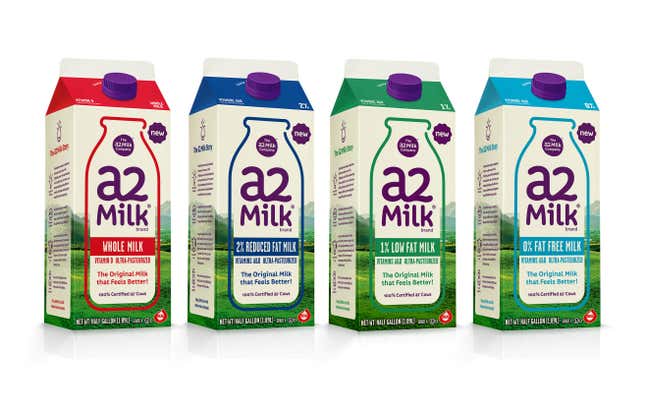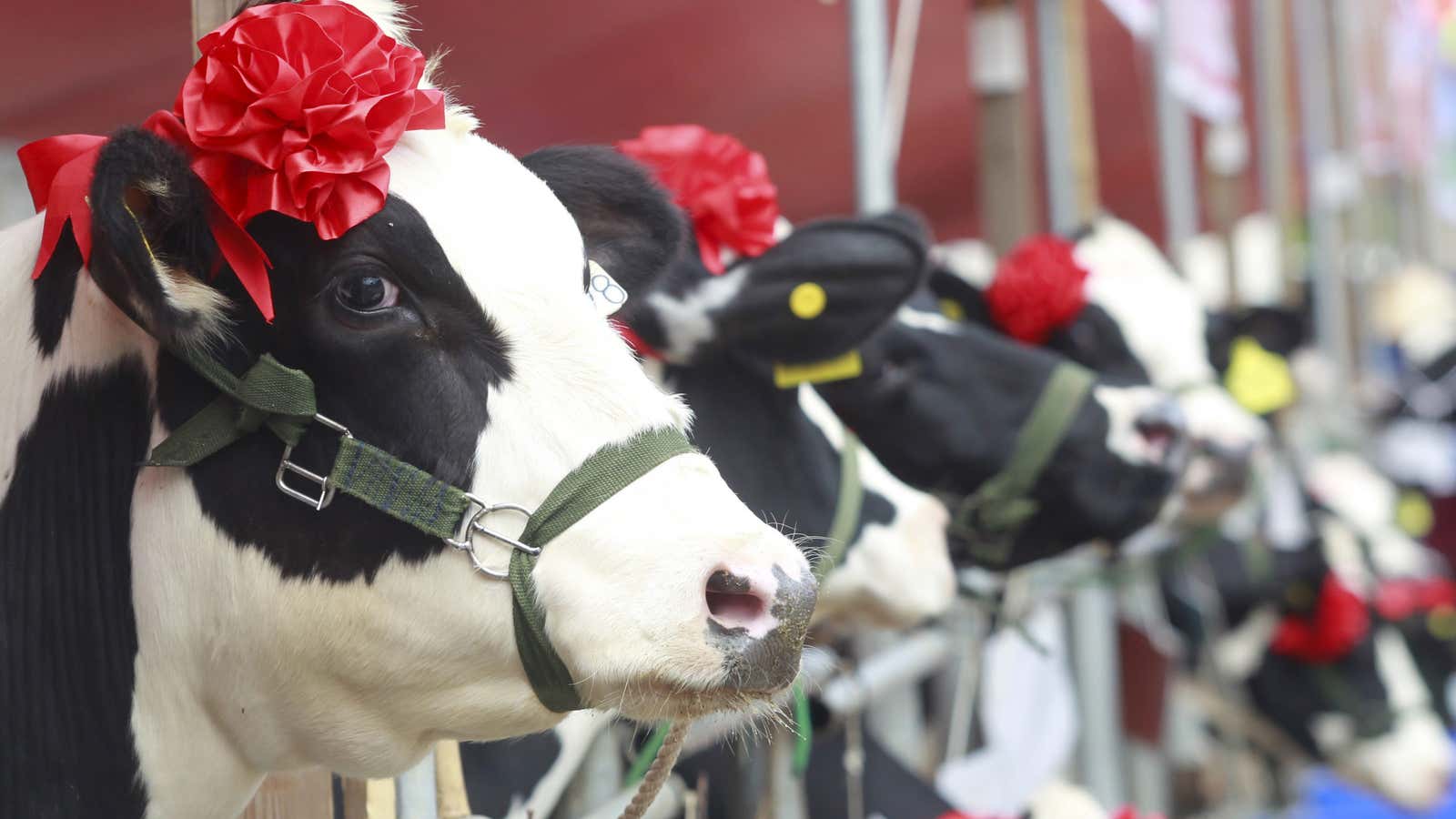American consumers are used to being confronted with a bewildering array of milk brands and milk alternatives. So shoppers in California might have missed it when a new milk brand, packed in brightly colored cartons with deep purple text and images of rolling green hills, appeared on their shelves last year. While the offering from Australia’s a2 Milk Company may not have stood out at first glance, it does differ from other brands in at least one regard: a2 isn’t promoting an alternative for milk-averse customers. Instead, it’s trying to get those customers to try milk again.
The a2 Milk Company produces cow’s milk they say is safe for many people with milk sensitivities to drink. The company is confident their product can find its niche in a crowded US market, and their optimism isn’t unwarranted. a2 milk accounts for over 12% of the fresh milk market in Australia since launching there about a decade ago, according to market research firm Euromonitor.
In the 1990s, New Zealand-based scientist and entrepreneur Corran McLachlan discovered the A1 and A2 proteins in cow milk, and found that many people who experience symptoms such as upset stomachs after drinking milk are not actually lactose intolerant—they just have trouble digesting A1 protein. This protein is present in some, but not all, cow’s milk.
So McLachlan started the a2 Milk Company, which patented a genetic hair test to determine if a cow produces milk with A1 or A2 proteins. The company works with dairies who use this test to only milk cows that naturally produce A2 protein alone (about one-third of cows).
Despite its success in Australia, the company faces mounting competition from alternatives such as lactose free milk and almond milk, which are catching on in the country, according to Nielsen Australia data.
The competition is starker in the US. Although millions of Americans suffer from milk sensitivities, most have found alternatives, many of which weren’t available in Australia when a2 broke into that market. To win over Americans, the a2 Milk Company has to explain what the A1 and A2 proteins are, how they impact the human body, and then convince people in the US that drinking cow’s milk is important enough to to give it a try.
That last point is key; there’s been a tremendous drop in milk consumption in the US in the past few decades. As recently as the 1970s, American adults were drinking about a cup a day, kids even more. By 2010, that milk consumption had declined to about 0.61 of a cup per day, the USDA found (pdf). Fluid milk availability peaked at 42.3 gallons per person in 1945. In 2012 availability had reached a record low (pdf) of 19.6 gallons per person. The Got Milk? campaign, which ran from 1993 until 2014, did little to bolster sales.

It wasn’t always this hard for milk products in the US. There was a point “when you didn’t have to spend any time at all talking to consumers about the beverage,” said Andrew M. Novaković, a professor of agricultural economics at Cornell University who studies the dairy industry. “Milk was talked about almost reverentially. A picture of a kid with a glass of milk in his hand was the picture of healthy eating. Well, that’s changed rather dramatically.”
Americans turned away from milk for a confluence of reasons, Novaković says. Breakfast habits have changed. Harried Americans consumers are opting for convenient, to-go options like yogurt and breakfast bars, instead of sitting down for a bowl of cereal. Eventually, the dairy industry began offering consumers small, personal bottles that were easier to drink on the go, but they were slow to cotton on to the trend. And while milk was one of a few options for lunch or dinner in the past, today it has a ton of competition from other beverages, like sodas, juices, flavored waters—and plant-based milks.
Coconut, soy, and new variants like pea-protein milk are all jostling for sales. Almond milk has become the country’s favorite milk substitute, with sales growth of 250% over the past five years, according to Nielsen. During that same period the traditional milk market shrunk by more than $1 billion.
Blake Waltrip, a2 Milk’s CEO in the US, feels consumers “don’t have to compromise” with plant-based or lactose-free milk. Waltrip is familiar with the intricacies of introducing American consumers to foreign staples. He previously worked as the CEO of the Ancient Harvest, also known as the Quinoa Corporation, named for its most well-known product. During his time with the company, sales doubled.
“A lot of people are leaving a very wholesomely nutritious beverage,” said Waltrip. He thinks a2 can win them back.
Cow’s milk does contain more calcium than soy milk and more protein than almond milk. But healthier or not, Novaković thinks Waltrip’s thinking is outdated.
“Folks in the dairy industry assume that everybody wants to be a milk drinker—’there but for the grace of God, you would be a milk drinker,’” Novaković said. “They don’t get that once you’ve grown up drinking soy beverages that becomes your normal, and any kind of milk is going to taste funny.”
But success in the US won’t require the kind of market share a2 Milk has in Australia, a company spokesperson said, because the US milk industry is still over $10 billion larger than Australia’s.
Much like in Australia, New Zealand, China, and the UK, where their milk is also sold, the company is looking to progressive, health-conscious, American consumers who have perhaps been avoiding milk due to digestive problems.
The company has been working with healthcare professionals in much the same way as a pharma company might when it’s promoting a new drug. Nutritionists, dietitians, general practitioners, and pediatricians can suggest a2 Milk as an alternative when patients have trouble digesting milk, explaining that those issues might have more to do with proteins than lactose. The company has also commissioned research into milk sensitivities and how A2 and A1 proteins are digested.
Meanwhile, in addition to California, in 2015, the company started selling a2 milk in parts of the Pacific Northwest, and Colorado, where the company’s US headquarters are based and has recently expanded sales to a limited number of stores nationally.
Novaković remains unconvinced. “These ‘super’ milks generally have not been terribly successful,” in terms of sales and consumer awareness, he said. In this category, he includes the Coca Cola-distributed Fairlife milk, which has more protein and calcium than traditional milk thanks to an ultrafiltration process, and Smart Balance’s Heart Right fat-free milk, which is supposed to taste more like 2% than other products on the market. Both milk products combined account for only 0.5% of the US dairy industry’s retail value, according to Euromonitor.
“This is part of an industry culture that wants to innovate but struggles with coming up with how,” Novaković said. “With milk products, it’s not quite so easy. Especially if you want to keep calling it milk.”
